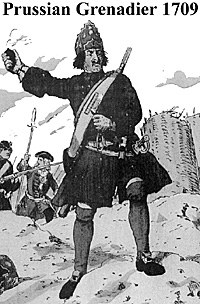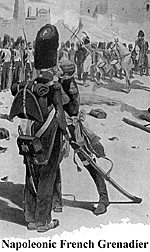 The term "grenadier" originally
meant an infantryman who used the
grenade. However, by the time of the
Napoleonic era the use of the grenade
had been discontinued except for
sieges, and the term grenadier had
come to mean the elite troops of the
army.
The term "grenadier" originally
meant an infantryman who used the
grenade. However, by the time of the
Napoleonic era the use of the grenade
had been discontinued except for
sieges, and the term grenadier had
come to mean the elite troops of the
army.
The grenadiers of the late 17th Century were chosen from the tallest and presumably bravest men of their units. As they were expected to hurl their grenades as far as possible, they wore hats without the large brims which were common at the time. These hats evolved into the distinctive mitre caps and bearskins used by Napoleonic grenadiers.
The practice of designating elite troops by such distinctive headgear even spread to the cavalry, as dragoon regiments raised companies of mounted grenadiers.
By the time of Marlborough (circa 1710) the grenade was dropped from use, but the term grenadier survived to describe the picked men of each regiment. By Frederick the Great'' time (circa 1740) all European armies had entire battalions of grenadiers, drawn from the line regiments, as their "cutting edge." These grenadier battalions were still common at the beginning of the Napoleonic wars.
Back into Line
During the course of the wars, both the French and the British decided that detaching a battalion's elite infantry was detrimental to the parent unit's morale, and the practice of stripping the battalions of their grenadier companies gradually fell into disuse. There were notable exceptions to this, however, such as Marshal Massena concentrating his battalions' grenadiers at Fuentes d'Onoro in 1811.
 In the French Army after 1806,
a grenadier was a member of the
grenadier company, one of the six
companies found in the French line
battalions. They wore the distinctive
red plumes, cords, and epaulettes for
their dress uniform. The only full
grenadier regiments were to be found
in Napoleon's Guard. These included
the grenadiers of the Young and
Middle Guard as well as the most
famous regiment of all the Old Guard.
The tradition of the mounted grenadier
was carried on by the Grenadiers
d Cheval; the elite heavy cavalry
regiment of the Guard.
In the French Army after 1806,
a grenadier was a member of the
grenadier company, one of the six
companies found in the French line
battalions. They wore the distinctive
red plumes, cords, and epaulettes for
their dress uniform. The only full
grenadier regiments were to be found
in Napoleon's Guard. These included
the grenadiers of the Young and
Middle Guard as well as the most
famous regiment of all the Old Guard.
The tradition of the mounted grenadier
was carried on by the Grenadiers
d Cheval; the elite heavy cavalry
regiment of the Guard.
Great Britain had no separate grenadier regiments until the first battalion of the Guard was designated as such after the victory of Waterloo. All other grenadiers were found in the elite companies which made up one of ten companies found in a British line battalion.
Austria kept up the 18th Century practice of concentrating the grenadier companies of the line infantry into converged grenadier battalions and even grenadier divisions. This suited the Austrians so well that no Austrian guard was ever formed.
However, at least one notable Austrian thought the idea of detaching the grenadier companies was pernicious. General Mack incorporated the grenadiers into the line regiments during the disastrous 1805 campaign. The idea was abandoned immediately following the Austrian surrender and Mack's arrest and imprisonment.
Prussia maintained Frederick the Great's tradition of converged grenadier battalions. This practice continued throughout the Napoleonic wars, long after many other Fredrician institutions had been discarded following the debacle of 1806-1807.
In October 1814, Prussian grenadier companies were permanently separated from the line infantry to form the First and Second Garde Grenadier regiments.
Russian Grenadiers
Russia loved the name grenadier. So much so, that more than half the infantry in the army before 1810 were called grenadiers. There were entire grenadier regiments, every line infantry regiment had a grenadier battalion, and the remaining line battalions all had grenadier companies.
Field Marshal Prince Barclay de Tolly felt (correctly) that this greatly cheapened the name grenadier. He therefore eliminated many of the grenadier regiments, all of the grenadier battalions of the line regiments, and the remaining grenadier companies of the line regiments were made up of half grenadiers and half tirailleurs. In all, over half of the grenadiers of the Russian army of 1810 were demoted.
Spain had a five-company organization for their line battalions, of which one of these was a grenadier company. They were normally detached and converged to form elite units, but their organization fell apart following the French invasion of 1808.
In later years, whether the grenadiers were detached or remained with the parent battalion depended on how much influence the British had upon the Spanish army in question. It seems that two of the newly-raised Spanish battalions were allowed to use the designation grenadier.
The minor states aped the practices of the major participants, starting with converged battalions which in most cases either became guard regiments or returned to their parent regiments as the wars went on.
While there was a tendency to end the Fredrician tradition of converged grenadier battalions, the high standing of the grenadiers remained, either as the best company of the battalion, or as a guard unit. The grenadiers' elite status continues to this very day in many countries.
Back to Empire, Eagles, & Lions Table of Contents Vol. 2 No. 8
Back to EEL List of Issues
Back to MagWeb Master Magazine List
© Copyright 1994 by Emperor's Headquarters
This article appears in MagWeb (Magazine Web) on the Internet World Wide Web.
Other military history articles and gaming articles are available at http://www.magweb.com
